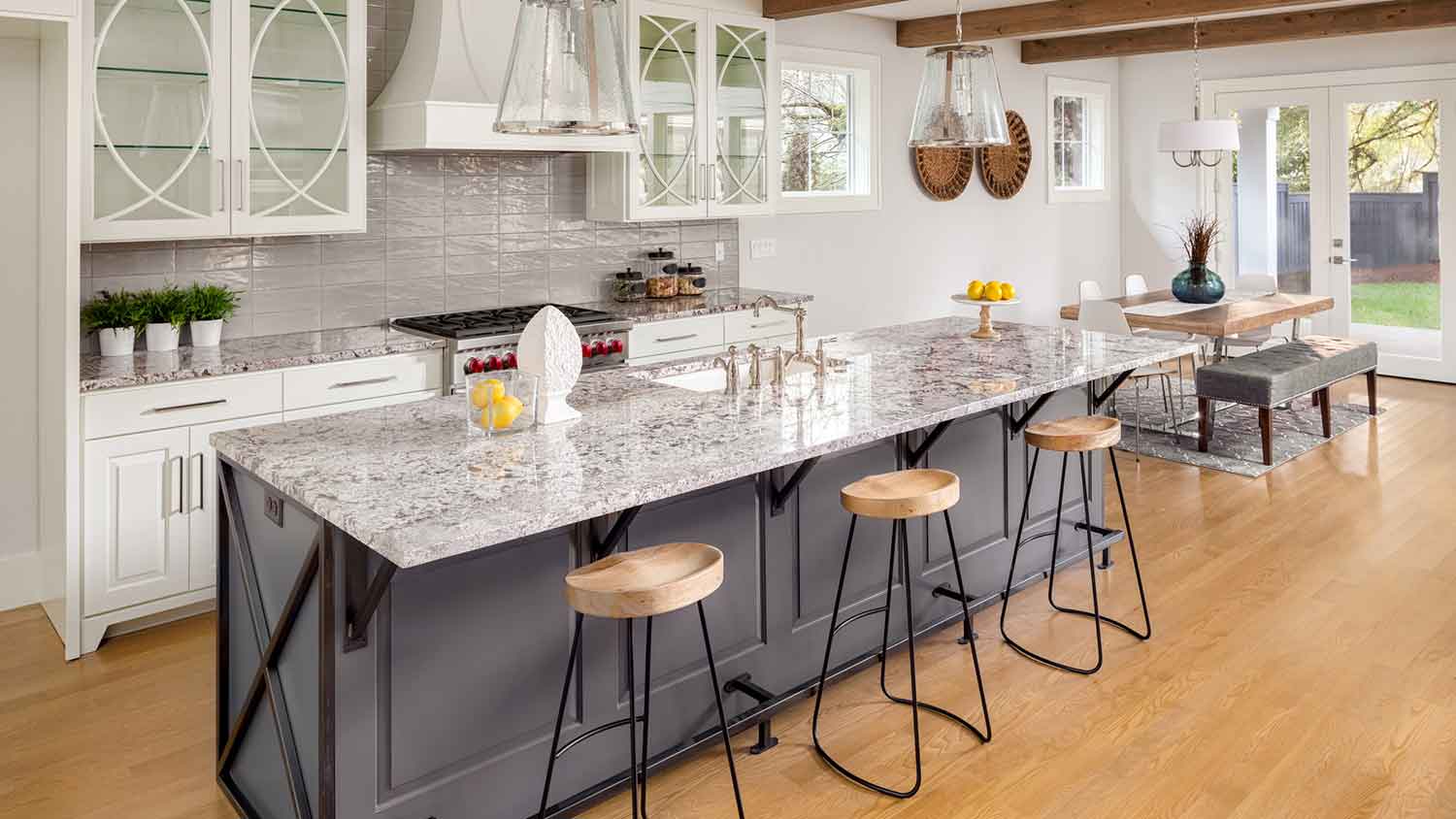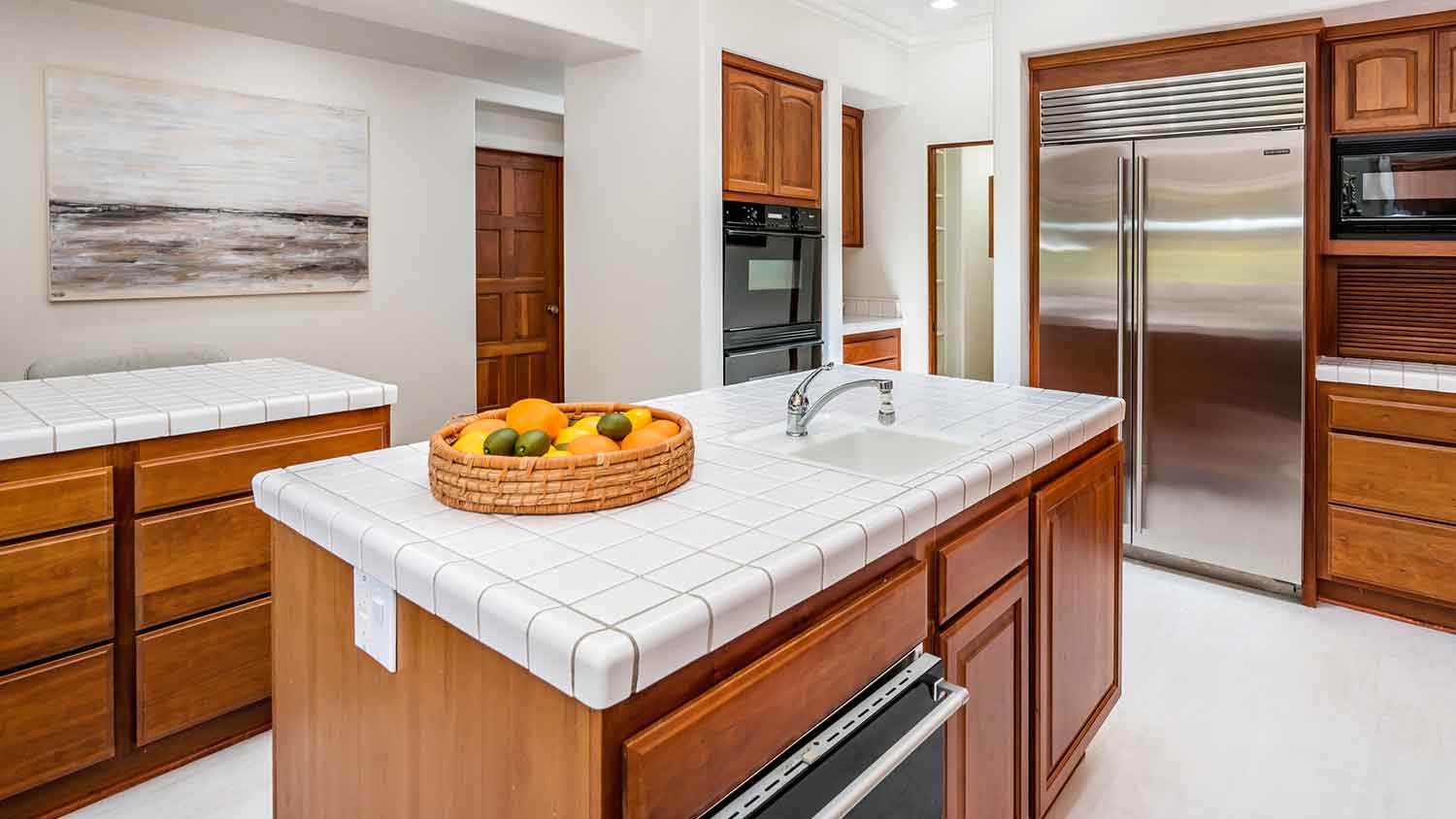How to Install Butcher Block Countertops Totally DIY
Make a countertop upgrade your weekend project


- Tape measure
- Framing square
- Wood clamps
- Drill
- Drill bits
- Butcher block slab
- Long strips of cardboard
- Hot glue
- Pencil
- Construction screws
Butcher block countertops are the perfect marriage of form and function—they’re basically oversized cutting boards (yes, you can cut directly on the surface) that exude farmhouse charm. A typical middle-of-the-road wood will cost less than granite and other natural stones. If you’re a handy homeowner, you can save even more by upgrading your countertops DIY. This guide will show you how to install butcher countertops like the pros.
Prepping to Install Butcher Block Countertops
When you’re installing butcher block countertops, you should let the wood acclimate. Wood tends to swell with heat and humidity. You don’t want a wonky countertop that warps after installation. Let the wood acclimate for 72 hours in the room where you plan to install it before you start taking measurements.
Before your countertop installation, have all your appliances in place (think: range, dishwasher, refrigerator, microwave, etc.). Ask your installer if you should prep anything else beforehand.
Prep the Room
 Photo: Bill Doss / Adobe Stock
Photo: Bill Doss / Adobe StockBefore you install your butcher block countertops, you’ll need to prep your space. Turn off your home’s water supply using the main shut-off valve. This step is extremely important. If you forget to turn off the water, say hello to water damage.
Once the water is off, you’ll need to:
Remove doors and drawers from your base cabinets to prevent damage
Remove your sink, disconnecting water lines and any garbage disposal units
Remove appliances, like your fridge or stove, if they’re in the way
Make a Template
You’ll have to cut your countertop to size, but before you do, it’s best to make a template. This helps you achieve the most accurate measurements. You can use long strips of cardboard or project panels as long as they have a straight edge, though some people prefer to use project panels because they’re sturdier.
Lay the strips along the edges of your countertop, creating an exact outline of the perimeter. Glue the strips together where they meet using hot glue. This frame is your perimeter guide, and you’ll draw around it to mark your cut lines.
Keep in mind that if you have a large or L-shaped countertop, you may need to connect two pieces of butcher block. Make sure you take measurements along with your template so you can check during the process and mark how the pieces will fit together. Sometimes, you’ll need to make an angled cut for a miter joint.
Add Cutouts to the Template (Optional)
If your countertop has cutouts, you’ll need to add them to the template. Some sink manufacturers provide a template for you, which is typically easier. If not, you can mark the cutouts the same way you marked the perimeter—by laying out strips of cardboard along the edge of the cutout to make a guide, then hot-gluing them together.
Make sure you connect the cutout guide with the perimeter guide using at least two cardboard or project panel strips. You don’t want the cutout template to shift when you move it. Precision is key. If your guide has the wrong measurements, your sink won’t fit.
Remove Your Existing Countertop
 Photo: photovs / iStock / Getty Images
Photo: photovs / iStock / Getty ImagesOnce you’ve made your template, you can remove your existing countertop. Unscrew the materials and pry them up from the adhesive, taking care not to damage your cabinets.
Mark the Butcher Block
Lay your template on top of the butcher block slab. If you have a butcher block with visible wood grain, make sure the grain is aligned with your template. Use a framing square to make sure your template is correctly aligned and the edge of the countertop is square. Trace around your template with a pencil to mark your cut lines—including any seams (where two pieces of butcher block meet) and the lines for your cutouts.
Cut the Butcher Block
Use your circular saw to cut your butcher block along the cut lines. Do one edge at a time, moving slowly and precisely. Check your work often. Once you’ve cut your butcher block, put it over your cabinets to check the sizing. If you need to, make adjustments with your saw using a fine-toothed blade and straightedge.
Create Your Cutouts
Next, you’ll need to make your cutouts. You should already have marked the cut lines on your butcher block. Double-check your measurements using your template. You can also place your butcher block over your cabinets to make sure it lines up correctly. Make adjustments if necessary.
When you’re ready to cut, drill pilot holes into the corners of your marked cut lines using a drill with a 3/8-inch bit. Depending on the countertop design, you can use a circular saw and/or jigsaw to cut along the outside edge of the cut lines until you’ve made the full cutout.
Join Butcher Block Slabs
Lay your countertop slabs over your base cabinets to see where they fit together. If you have a large or L-shaped countertop, you’ll need to join multiple pieces of butcher block at a seam. There are a few different ways to do this: using biscuit joints, screws, or miter bolts. You can use multiple methods, depending on the design:
Biscuit joints: You’ll need to mark the location of the biscuits (or disks) on each side of the butcher block surfaces you want to join. Space them in the center of the edge, 12 inches apart. Use a biscuit joiner to cut the slots into the edge of your countertop, glue the biscuits in place with wood glue or construction adhesive, and then align the boards. Allow the glue to dry.
Pocket holes: Drill pocket holes on the underside of your countertop, angled to allow you to screw one piece of wood to the adjoining countertop slab.
Miter bolts: Line up the two pieces of butcher block and mark their placement. Use a router with a pattern bit to cut a slot into the underside of your countertop. Join the edges of your countertop using wood glue or construction adhesive, then wipe the excess away. Screw the miter bolt into place.
Fill the Countertop Seams
Apply wood filler to the countertop seams using a putty knife. Wood filler absorbs stain and can give your butcher block countertop a more seamless finish. Wait for the filler to dry per the manufacturer’s instructions.
Prefinish Your Countertop
 Photo: FotoHelin / Adobe Stock
Photo: FotoHelin / Adobe StockTo give your countertop a smooth finish, sand the surface of your butcher block with fine-grade sandpaper. Take extra care to smooth out the wood filler over the seams and cut edges. Wipe the countertop with a damp cloth when you're done sanding.
Finish Your Countertop
One of the cons of butcher block countertops is that they scratch—especially if you’re using it as a cutting board. This is part of the natural wear and tear of a wood countertop, but you’ll need to choose your finish wisely. Some homeowners use polyurethane, but this will show scratches and will erode over time. Instead, use a food-grade mineral oil on the entire surface of your countertop.
Apply the oil per the manufacturer’s instructions using cotton cloths. Make sure to apply oil around the sink cutouts so water can’t soak into the sides.
Secure Your Countertop
 Photo: OLGA RYAZANTSEVA / iStock / Getty Images
Photo: OLGA RYAZANTSEVA / iStock / Getty ImagesIt may be easier to do this step with a helper. Apply construction adhesive on the top edge of your base cabinets, then put your butcher block countertop in place. Secure the countertop with wood clamps.
Next, attach countertop support brackets to your base cabinets, then screw your countertop in place. Wait for the adhesive to dry before removing the clamps, then caulk around your sink using a smooth silicone caulk. Allow the caulk to dry.
Reconnect Your Plumbing and Appliances
Once your countertop is fully secured, you can install your sink and reconnect the plumbing. Reattach your cabinet doors and drawers, reinstall your kitchen appliances, and—as long as the plumbing and water lines are back in place—you can turn on your water.
DIY vs. Hiring a Pro
The typical butcher block countertop costs about $2,000 to $5,000 if you hire a pro. You can save $5 to $30 per square foot on labor if you do the job yourself, but it may not be the most economical option unless you already own the equipment and really know what you’re doing.
This project requires precise measurements and meticulous cuts. If you don’t do it right, you could end up damaging your kitchen or having to buy a whole new countertop. Rather than risking costly repairs, hire a countertop installer. This is especially important if your job requires plumbing or electrical work.
To find the best value, get estimates from at least three countertop installers near you. Always ask for references and check online reviews.
Frequently Asked Questions
You should use glue and screws when installing butcher block countertops. Opt for a construction adhesive or wood glue applied along the top edge of your base cabinets. For added strength, install support brackets on the base cabinets, then secure your countertop with screws. Make sure you only tighten the screws to the point where the butcher block is snug against the cabinet and don’t overtighten.
You’ll want to finish butcher block countertops with a food-safe sealant. Mineral oil and tung oil are great options for a velvety, matte finish. They’re water resistant, but you’ll need to reapply them regularly. Some homeowners also use polyurethane, but this option shows scratches much more prominently—which isn’t great for people who use their countertops as a cutting board.
You don’t need a cutting board. In fact, cutting is the original purpose of butcher block countertops. That said, wood is porous and can harbor germs. You’ll need to clean your countertop thoroughly after use. Knives can also scratch the surface. This adds to the patina of the wood, but not everyone likes the look—in which case, you may want to use a cutting board.
















